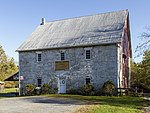Union Bryarly's Mill
Union Bryarly's Mill is a historic flour and grist mill complex and national historic district located at Darkesville, Berkeley County, West Virginia, USA. It encompasses four contributing buildings and two contributing sites. The buildings are the Bryarly Mill, Mansion House, a log smokehouse and combination ice house building, the log miller's house (1751), the site of a distillery and foundation containing archaeological remains. The mill was built about 1835 and is a two-story, three-bay brick building with a gable roof. The Mansion House was built about 1835 and is a two-story, L-shaped frame dwelling on a stone foundation.It was listed on the National Register of Historic Places in 1980.
Excerpt from the Wikipedia article Union Bryarly's Mill (License: CC BY-SA 3.0, Authors).Union Bryarly's Mill
Geographical coordinates (GPS) Address Nearby Places Show on map
Geographical coordinates (GPS)
| Latitude | Longitude |
|---|---|
| N 39.371111111111 ° | E -78.028055555556 ° |
Address
25428
West Virginia, United States
Open on Google Maps








